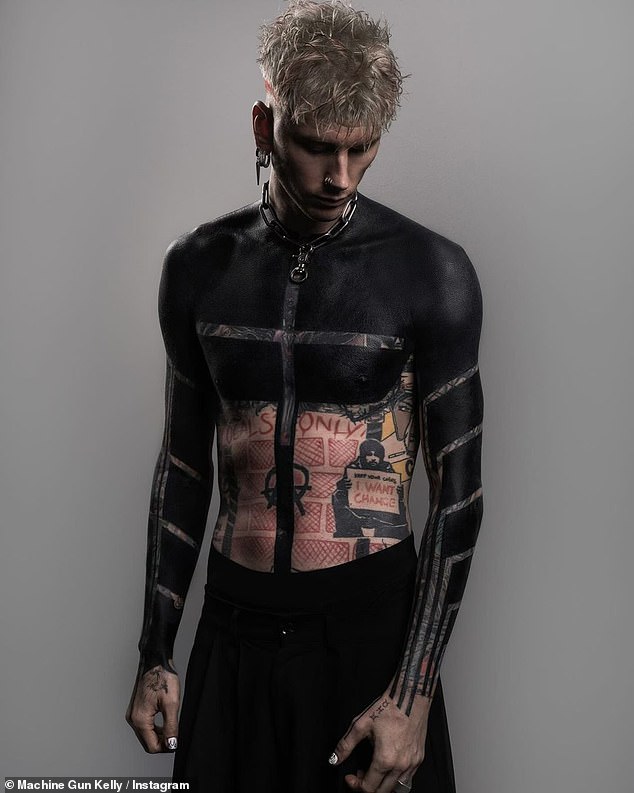More than nine out of ten people who get tattoos in the United States may be unknowingly exposing themselves to chemicals that cause organ damage, a study suggests.
Tests conducted in New York on 54 ink samples found that 45 contained compounds not listed on the label.
The most common was polyethylene glycol, a compound that has been linked to organ damage, including a type of necrosis in the kidneys.
Others included 2-phenoxyethanol, which has been linked to nervous system dysfunction in babies, and an antibiotic.
The Food and Drug Administration (FDA) will begin regulating tattoo inks in the coming months after a vote in Congress in late 2022 gave the agency the power to do so. Lawmakers decided on the change after multiple reports of illnesses caused by contaminating microbes in tattoos.

Machine Gun Kelly’s new tattoo has come under fire from fans after he covered the top half of his body in black ink.




Other celebrities who have adorned their bodies with tattoos include Justin Bieber (left) and Adam Levine (right).
Tattoo inks are regulated as “cosmetics,” along with makeup and body lotions, among others, under the Cosmetics Regulation Modernization Act (MoCRA).
This was the biggest overhaul of cosmetics regulation since 1938 and gave the FDA new powers, including monitoring ingredients in tattoos.
So far, the agency has released draft guidance on tattoo inks as it prepares to regulate the products.
About a third of Americans currently have tattoos, surveys suggest, and among adults ages 30 to 49, up to half have tattoos.
Tattoos are also becoming more common among celebrities, which may be fueling their popularity, with figures like Justin Bieber joining the trend.
And more extreme versions, like Machine Gun Kelly’s “blackout” tattoos, are also becoming more common.
In the study, published in the journal Analytic chemistryThe scientists collected ink samples from nine American manufacturers.
The ingredients found in the tests were then compared to those listed on the ink labels to reveal discrepancies.
Polyethylene glycol, found in inks, can be used in tattoos as a thickening agent, making it easier to apply. It is also used in other products such as body washes, makeup bases, and even hairsprays.
Experts suggest that 2-phenoxyethanol, which is also found in some of the inks, can be added as a preservative as it can prevent microbes from growing in the ink once the bottle is opened.
The chemical is also used in moisturizers, eye shadows and sunscreens for these purposes, and is allowed to be used up to a one percent concentration in the products.
The tests also detected an antibiotic, propylene glycol, which is typically used for urinary tract infections (UTIs) and was not declared on the label. It is also possible that it was added to reduce contamination risks.
This antibiotic has also previously been linked to allergic reactions that can cause skin conditions such as eczema.
The tattoo inks that tattoo artists place on the body can be absorbed by macrophages (a type of white blood cell) which then hold the ink in the skin, holding the tattoo in place.
But in some cases it is possible for impurities to leak into the bloodstream and spread throughout the body, increasing the risk of unwanted side effects such as organ damage.
Dermatologists have previously warned against tattoos, saying they make skin cancer difficult to detect and contain impurities that can increase the risk of complications.
Dr. Marc Everett, a New York plastic surgeon who was not involved in the study, previously suggested that tattoo inks may also cause inflammation in lymph nodes, which also help transport fluids through the body.
It has previously been suggested that swelling can damage the body’s immune system, reducing its ability to fight infection.


Tests carried out in New York on 54 ink samples found that up to 45 contained impurities not listed on the label (file image)
Dr. John Swierk, a chemist at Binghampton University who led the study, said: “We hope that manufacturers will take this as an opportunity to re-evaluate their processes, and that artists and customers will take this as an opportunity to push for better labeling. and manufacturing”. .’
He added: “This is the first study to explicitly look at inks sold in the United States and is probably the most comprehensive because it looks at pigments.”
‘These nominally remain on the skin, [along with] the carrier package, which is where the pigment is suspended.
He added: ‘Our goal in much of this research is to empower artists and their clients. Tattoo artists are serious professionals who have dedicated their lives to this craft and want the best possible results for their clients.
“We are trying to highlight that there are some deficiencies in manufacturing and labeling.”
